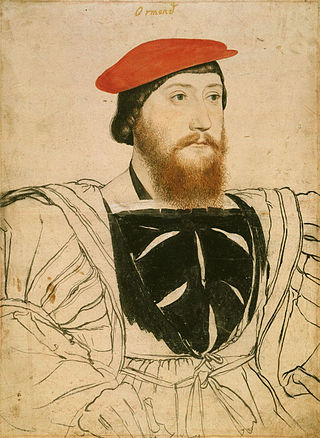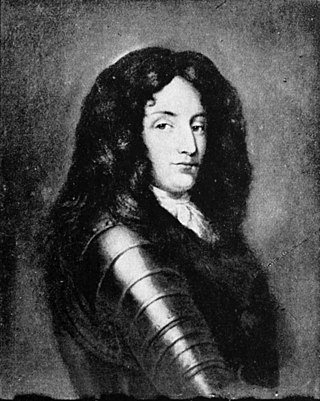Later life and death
Their children were raised as Protestants. Their daughters married into the Herberts (twice), Merediths (twice), Sandes', Creaghs, Stacks, Hewsons, Collis', Rices and Days.
In 1708 FitzGerald conformed to the established religion. His marriage, conversion, and the subsequent marriages of his children further alienated the Knights of Kerry from the local Catholic populace. FitzGerald became Deputy Lieutenant of Kerry.
FitzGerald died at Ballinruddery Castle, near Listowel, on 9 December 1729.

The Knight of Glin, also known as the Black Knight or Knight of the Valley, was an hereditary title held by the FitzGerald and FitzMaurice families of County Limerick, Ireland, since the early 14th century. The family was a branch of the FitzMaurice/FitzGerald Dynasty commonly known as the Geraldines and related to the now extinct Earls of Desmond who were granted extensive lands in County Limerick by the Crown. The title was named after the village of Glin, near the Knight's lands. The Knight of Glin was properly addressed as "Knight".

Gerald FitzGerald, 14th Earl of Desmond, also counted as 15th or 16th, owned large part of the Irish province of Munster. In 1565 he fought the private Battle of Affane against his neighbours, the Butlers. After this, he was for some time detained in the Tower of London. Though the First Desmond Rebellion took place in his absence, he led the Second Desmond Rebellion from 1579 to his death and was therefore called the Rebel Earl. He was attainted in 1582 and went into hiding but was hunted down and killed.
David Fitz-James de Barry, 18th Baron Barry, 5th Viscount Buttevant (1550–1617), sided initially with fitz Maurice, the rebel, in the 1st Desmond rebellion but changed sides and fought against the rebels. He also fought for the crown in the Nine Years' War.

James Butler, 9th Earl of Ormond and 2nd Earl of Ossory, known as the Lame, was in 1541 confirmed as Earl of Ormond thereby ending the dispute over the Ormond earldom between his father, Piers Butler, 8th Earl of Ormond, and Thomas Boleyn, 1st Earl of Wiltshire. Butler died from poison in London.
Robert FitzGerald, 17th Knight of Kerry was an Irish politician, barrister and hereditary knight.
John FitzGerald, 15th Knight of Kerry was an Irish politician and hereditary knight.

Sir Daniel O'Brien, 1st Viscount Clare also called Donal was an Irish politician and soldier. He was born a younger son of Connor O'Brien, 3rd Earl of Thomond. He fought against the insurgents at Tyrone's Rebellion, but for the insurgents in the Irish Rebellion of 1641 and the Irish Confederate Wars. He resisted the Cromwellian conquest of Ireland. He joined Charles II of England in exile and was in his eighties made a viscount at the Restoration.

Connor O'Brien, 2nd Viscount Clare was the son of Daniel O'Brien, 1st Viscount Clare and Catherine FitzGerald, a daughter of Gerald, 14th Earl of Desmond.
Thomas Fitzmaurice, 18th Baron Kerry (1574–1630), also called Baron Lixnaw, fought in the Nine Years' War.
Cormac na Haoine MacCarthy Reagh, 13th Prince of Carbery (1490–1567) was an Irish chieftain who owned almost half a million acres in south west Ireland.

Colonel Thomas Butler of Garryricken, also known as Thomas Butler of Kilcash was an Irish Jacobite soldier. He commanded a regiment, Thomas Butler's foot, during the Williamite War and fought at the Battle of Aughrim in 1691 where he was taken captive. His son John would, de jure, become the 15th Earl of Ormond.
The High Sheriff of Kerry was the British Crown's judicial representative in County Kerry, Ireland from the 16th century until 1922, when the office was abolished in the new Free State and replaced by the office of Kerry County Sheriff. The sheriff had judicial, electoral, ceremonial and administrative functions and executed High Court Writs. In 1908, an Order in Council made the Lord-Lieutenant the Sovereign's prime representative in a county and reduced the High Sheriff's precedence. However, the sheriff retained his responsibilities for the preservation of law and order in the county. The usual procedure for appointing the sheriff from 1660 onwards was that three persons were nominated at the beginning of each year from the county and the Lord Lieutenant then appointed his choice as High Sheriff for the remainder of the year. Often the other nominees were appointed as under-sheriffs. Sometimes a sheriff did not fulfil his entire term through death or other event and another sheriff was then appointed for the remainder of the year. The dates given hereunder are the dates of appointment. All addresses are in County Kerry unless stated otherwise.

James fitz John FitzGerald, 13th Earl of Desmond, also counted as the 14th, ruled 22 years, the first 4 years as de facto earl until the death of James FitzGerald, de jure 12th Earl of Desmond, called Court Page, who was murdered by James fitz John's brother Maurice fitz John FitzGerald, called Totane. James fitz John FitzGerald maintained himself in power by skilful diplomacy, avoiding armed conflict and destruction. He was appointed Lord Treasurer of Ireland in 1547.

James fitz Maurice FitzGerald, 10th Earl of Desmond, also counted as the 11th, plotted against King Henry VIII with King Francis I of France in 1523 and with Emperor Charles V in 1528 and 1529.

James fitz Maurice FitzGerald, de jure 12th Earl of Desmond, also counted 13th, was called Court Page as he grew up as a hostage for his grandfather Thomas FitzGerald, 11th Earl of Desmond, the Bald, at the court of Henry VIII. He should have succeeded this grandfather in 1534, but John FitzGerald, de facto 12th Earl of Desmond usurped the earldom and was followed in 1536 by his son James, fitz John. In 1539 the lord deputy of Ireland, Leonard Grey seized some Desmond land in southern County Cork and handed it to Court Page, who came to Ireland to claim his rights but was killed by Maurice fitz John FitzGerald, called Totane. He was succeeded by James fitz John, now rightful 13th earl.
Helen Burke, Countess Clanricarde, also styled Helen FitzGerald, was brought to France by her mother fleeing the Cromwellian conquest of Ireland, against which her father, the 2nd Earl Muskerry, resisted to the bitter end. In France, she was educated at the abbey of Port-Royal-des-Champs together with her cousin Elizabeth Hamilton. She married three times. All her children were by her second husband, William Burke, 7th Earl of Clanricarde. She was the mother of Ulick Burke, 1st Viscount Galway, Margaret, Viscountess Iveagh, and Honora Sarsfield.
David Roche, 7th Viscount Fermoy (1573–1635) was an Irish magnate, soldier, and politician.
Sir Valentine Browne, 1st Baronet, of Molahiffe, owned a large estate in south-west Ireland and was a lawyer who served as high sheriff of County Kerry.
Donal MacCarthy Reagh of Kilbrittain was an Irish magnate who owned the extensive lands of Carbery in south-western County Cork.
Sir John FitzGerald of Dromana was the last of the FitzGeralds of Dromana. He sat as MP for Dungarvan in the Irish Parliament of 1661–1666.





